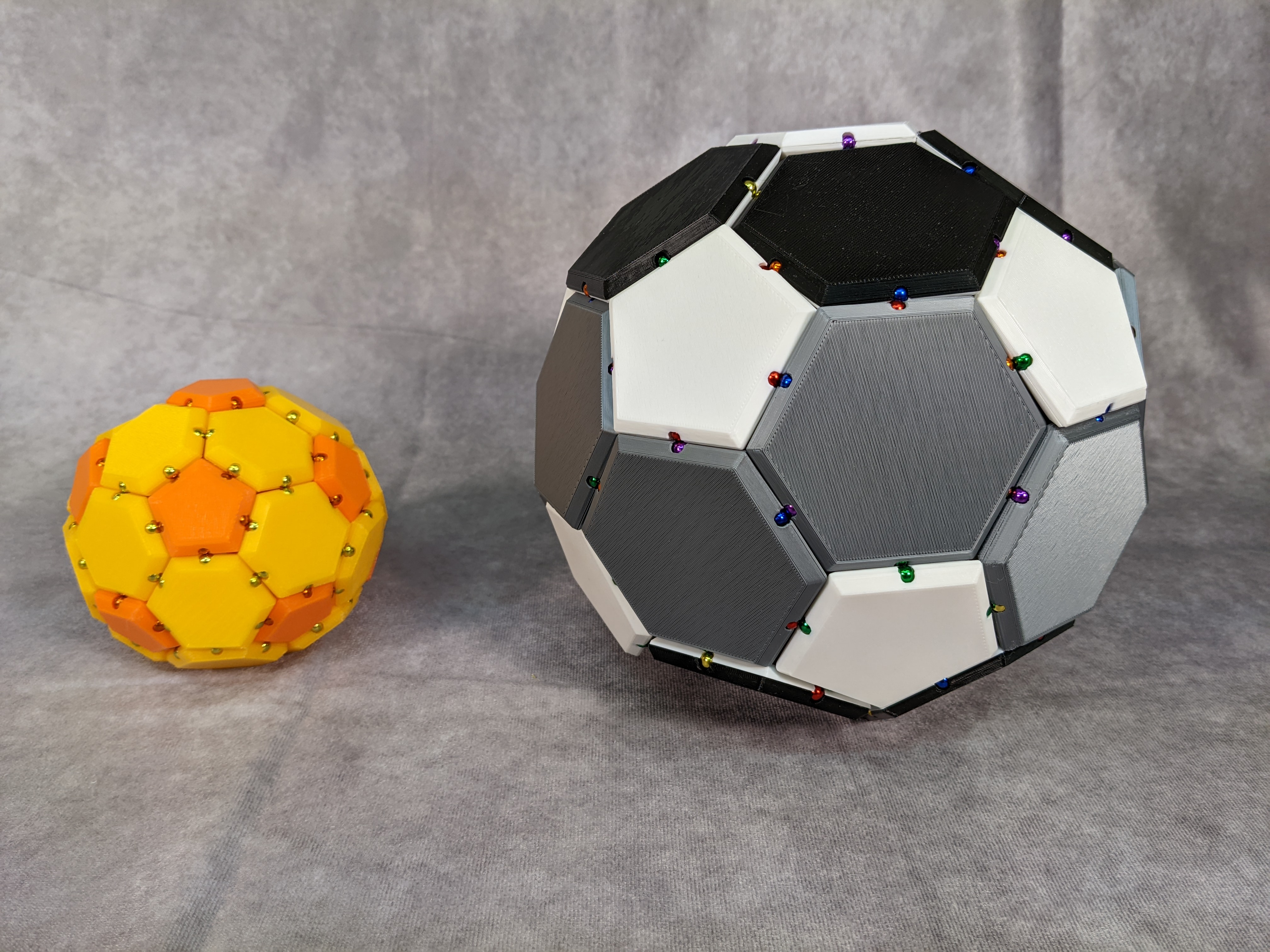
Polygons to Polyhedrons and More - 30mm Sides
prusaprinters
<p>Magnetic spheres are used to make 3D printed polygons that can be used as an educational math tool, a fidget device, or a unique set of magnetic building blocks. The polygons can be used to make polyhedrons and other fun shapes.</p><p>Triangles, squares, pentagons, and hexagons are made to incorporate spherical magnets on each side. The pockets for the 5mm magnets are slightly larger than the magnets so they can float in the space available and re-orient themselves as needed. So, any 2 sides of any 2 shapes can be attracted to each other.</p><p>Each set of polygons is available in 20mm, 30mm, and 40mm sides. Each size is published as a different make because there are so many files. I like the 20mm size as a fidget toy. Polyhedrons like a dodecagon and truncated icosahedron (soccer ball/football) can easily be made, however, the 20mm triangles don’t work too well. The magnets are too close together and internal attraction causes interference on the edges. Use brims if printing the 20mm triangles. For 30mm, every polygon works great to make all kinds of polyhedrons. At 40mm, size starts to become a problem. The dodecahedron works but the truncated icosahedron soccer ball is very shaky and collapses when the last pentagon is put in place. But the shape can be made (see photos) with the internal support tube which I have included to support the top piece. A 40mm re-design could use double magnets on each side.</p><p>Each polygon is printed in 2 halves to which the magnets are added and then the halves glued together. Be careful not to glue the magnets in place. There are alignment pins which help the assembly. The smaller polygons are difficult to assemble because the magnets attract each other before the top can be put on. So I’ve included Assemblers for each polygon size. Assemblers are complementary shapes which go around the outer edges of the polygons. They will hold magnets in place in the lower half (with alignment pins) while glue is added to the top half and then put on top of the bottom and magnets while in the Assembler. Again, use glue sparingly so the magnets are not glued in place.</p><p>The smaller Assemblers are difficult to assemble themselves. But since they only need to be made once, I tape or somehow hold magnets to the outside of the Assemblers temporarily to hold the internal magnets in place until assembly is complete. The Assemblers come in handy when making a large number of polygons. Assembly becomes fast. Assemblers and their mating polygons make great fidget toys themselves.</p><p>The 5mm magnets I used are the brand Buckyballs (<a href="https://www.buckyballsstore.com">https://www.buckyballsstore.com</a>). There are generics available but I can’t vouch for their magnetic strength. If you want to take it a step further, there are smaller and larger spherical magnets available. The 20mm pentagons are similar to the Speks Geode Magnetic Fidget Sphere currently being sold.</p><p>Except for the 20mm triangles (need brims), all parts printed without supports. 0.2mm printed smoother shapes than 0.1mm. Infill was set at 15%. For me, these did not print well in PET. PLA created fewer artifacts that might impede magnet movement.</p><p>There are many resources on polyhedrons. Here are some starting points:</p><p><a href="https://mathworld.wolfram.com/Polyhedron.html">https://mathworld.wolfram.com/Polyhedron.html</a></p><p><a href="https://en.wikipedia.org/wiki/Regular_polyhedron">https://en.wikipedia.org/wiki/Regular_polyhedron</a></p><p><a href="https://en.wikipedia.org/wiki/Archimedean_solid">https://en.wikipedia.org/wiki/Archimedean_solid</a></p><p><a href="https://en.wikipedia.org/wiki/Quasiregular_polyhedron">https://en.wikipedia.org/wiki/Quasiregular_polyhedron</a></p><p><a href="https://en.wikipedia.org/wiki/Johnson_solid">https://en.wikipedia.org/wiki/Johnson_solid</a></p><p><a href="https://en.wikipedia.org/wiki/Dodecahedron">https://en.wikipedia.org/wiki/Dodecahedron</a></p><p><a href="https://en.wikipedia.org/wiki/Truncated_icosahedron">https://en.wikipedia.org/wiki/Truncated_icosahedron</a></p><p><br><a href="https://en.wikipedia.org/wiki/Icosahedron#:~:text=In%20geometry%2C%20an%20icosahedron%20(%2F,%2F)%20or%20%22icosahedrons%22">https://en.wikipedia.org/wiki/Icosahedron#:~:text=In%20geometry%2C%20an%20icosahedron%20(%2F,%2F)%20or%20%22icosahedrons%22</a>.</p>
With this file you will be able to print Polygons to Polyhedrons and More - 30mm Sides with your 3D printer. Click on the button and save the file on your computer to work, edit or customize your design. You can also find more 3D designs for printers on Polygons to Polyhedrons and More - 30mm Sides.
